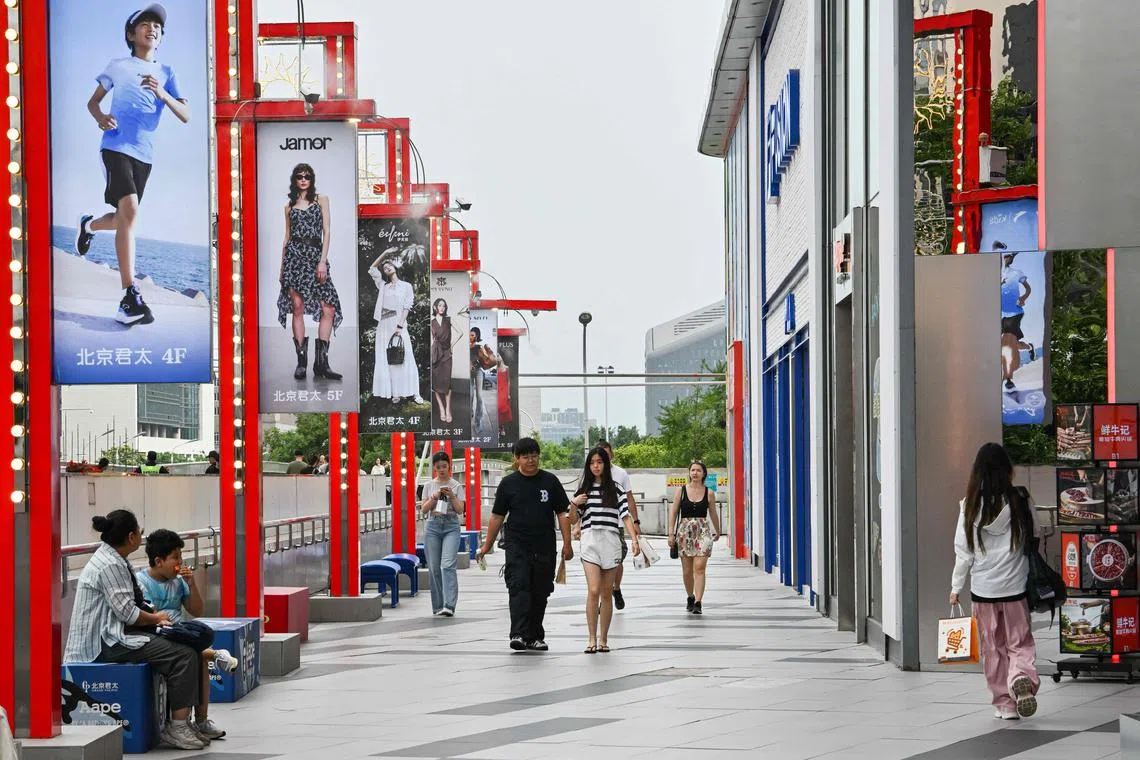China’s economy grows 5.3% in first half of 2025 in show of resilience; tougher times lie ahead
Sign up now: Get ST's newsletters delivered to your inbox

After a strong start to the year with 5.4 per cent growth in the first quarter, the growth of China’s economy in the second quarter slowed to 5.2 per cent.
PHOTO: AFP
Follow topic:
BEIJING – China’s economy grew 5.3 per cent in the first half of 2025, official data showed on July 15, defying gloomy forecasts even as ongoing trade tensions with the United States slowed momentum in the second quarter.
The headline gross domestic product (GDP) figure for the first half of 2025 announced by China’s National Bureau of Statistics is broadly in line with the government’s full-year growth target of “around 5 per cent”.
After a strong start to the year with 5.4 per cent growth in the first quarter, the growth in the second quarter slowed to 5.2 per cent, as trade tensions and a prolonged property slump weighed down the world’s second-largest economy.
On a quarterly basis, China’s GDP grew 1.1 per cent in April to June, easing from a 1.2 per cent gain in the previous quarter.
China has so far sidestepped an abrupt downturn, thanks to a fragile trade truce struck with the US in mid-May
June’s trade figures received a lift from the tariff reprieve, which saw duties on Chinese goods cut to around 55 per cent
Exporters raced to ship out orders ahead of an August deadline, giving trade a temporary boost.
China’s central bank and financial regulators in May had unveiled a slew of policy steps, including cutting interest rates and injecting additional liquidity into the market, to shore up the economy.
Mr Gary Ng, a senior economist at investment bank Natixis in Hong Kong, told The Straits Times that the data shows some resilience from front-loading, cost advantages in exports and domestic consumption supported by subsidies.
“Still, the underlying price pressures, the lack of rebound in real estate and waning manufacturing investment can pressure growth in the second half of the year,” he said.
Consumer spending remains a weak spot. In June, retail sales growth slowed to 4.8 per cent compared with a year ago.
It was also down from the 6.4 per cent year-on-year increase in May.
“Domestic effective demand is insufficient, and the foundation for economic recovery and growth needs to be further consolidated,” China’s National Bureau of Statistics said in a statement on July 15.
China has expanded a trade-in programme that began in 2024 to encourage more domestic spending by providing subsidies for families to buy or upgrade electric cars, mobile phones, air-conditioners and other manufactured goods.
China’s property market has, likewise, continued to struggle, with real estate investment falling 11.2 per cent year on year in the first half of the year. New home prices across China’s 70 largest cities have also been falling.
Experts say increasing external uncertainties due to the US-China trade war could raise the pressure on policymakers to roll out additional stimulus to support growth.
The question is whether Beijing will step in more forcefully or allow a mild deceleration, now that it has some cushion in the form of first-half GDP growth that exceeded the full-year target.
Ms Sarah Tan, an economist at Moody’s Analytics, said in a note on July 15 that exports alone cannot compensate for the drag from weak domestic demand.
“Without stronger, sustained policy support and structural reforms to boost household incomes and confidence, China’s recovery risks losing more momentum in the second half,” she said.
Investors will be watching for signs of fresh stimulus at the upcoming July meeting of the Chinese Communist Party’s Politburo, a group of 24 top officials who oversee the party and central government led by President Xi Jinping.
Ms Dan Wang, China director at political risk consultancy Eurasia Group, told ST that a larger stimulus “is clearly needed”, likely via urban renovation programmes and infrastructure upgrades such as roads and pipelines.
The Chinese government will need to issue more Treasury bonds to support projects, which may come in the National People’s Congress meetings in August or October, as was the case in 2023, said Ms Wang.
On July 15, Beijing said it will “steadily advance renovation of urban villages and dilapidated houses”, following the first high-level urban planning meeting in a decade.
Still, Ms Wang believes that Beijing is unlikely to meet its full-year growth target of around 5 per cent, despite beating expectations for the second-quarter growth.
“The real question is by how much. We believe it will defend a floor of 4 per cent, which remains the minimum politically acceptable level,” she said.
There are, however, glimmers of optimism.
On July 15, Nvidia announced plans to resume sales of its H20 artificial intelligence chip to China, after it was forced to shut down sales about three months ago.
Pinpoint Asset Management president and chief economist Zhiwei Zhang said the Nvidia news sends a “positive signal”, along with a possible visit by US President Donald Trump to China after a meeting of top diplomats from both sides set the stage for deeper exchanges.
“If the threat of trade war diminishes at least in the short term, the chance of a large fiscal stimulus in China also declines,” said Dr Zhang.


